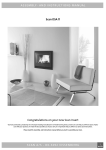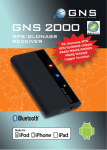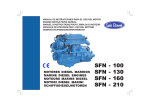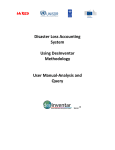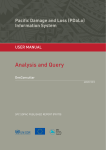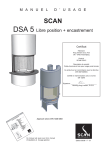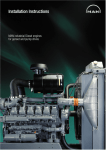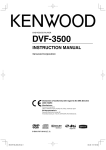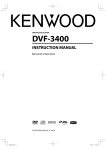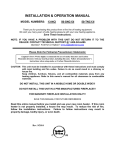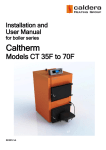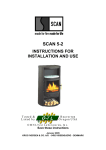Download SCAN 58 - series Technical data
Transcript
A S S E M B LY- A N D I N S T R U C T I O N S M A N U A L Scan 58 - series Congratulations on your new Scan wood-burning stove You have purchased a product by one of Europe’s leading manufacturer’s of wood-burning stoves, and we are sure that you will have years of pleasure with your purchase. To make the best possible use of your stove, it is important that you follow our advice and instructions. Please read this Assembly- and instructions manual before you start to assemble your stove. S C A N A / S - D K- 5 4 9 2 V I S S E N B J E R G CONTENTS 2 Table of contents Technical data .............................................................................................. 3 Installation Safety Technical data and dimensions Dimension sketch for Scan 58 - series Type plate Assembly ...................................................................................................... 10 Transport brackets Service box Additional accessories Positioning your wood-burning stove Positioning near to non-flammable materials Distance to furniture Diatance to flammable walls Product registration number Adjusting screws Load bearing foundation Floor plate Existing chimney and pre-fabricated element chimney Connection between stove and steel chimney Requirements for chimney Connection with 90° elbow pipe Fitting the stove onto the plinth Fresh air intake Closed combustion system Connecting piece top outlet Preparing the stove for rear outlet Wall-hung model Fitting the Scan 58 wall-hung model Scan 58-9 and Scan 58-10 Scan 58-9 and Scan 58-10 with high top Accessories .................................................................................................. 20 Mounting of high top for Scan 58-7 and Scan 58-8 Wall mounting kit for Scan 58 with high top Heat accumulating stones for high top Fitting the soapstone top Fitting a storage door Instruction for use ................................................................................... 26 CB technique Primary air Secondary air Baffle plates Ash drawer Handle for riddling grate Instructions for heating ......................................................................... 27 Lighting Handling fuel Maintenance .............................................................................................. 29 Troubleshooting ........................................................................................ 31 T E C H N I C A L D ATA 3 Installation Technical data and dimensions The house owner is responsible for ensuring that all necessary national and local safety measures are observed during installation and fitting and also responsible for observing the fitting and operating instructions detailed in this manual. Materials: When you install any kind of fireplace or stove, you must inform the local authorities. You are also responsible for calling in a chimney sweep to inspect and authorize the installation. Weight Scan 58: ca. 100 kg Weight Scan 58-9 and Scan 58-10: ca. 160 kg To ensure best-possible functionality and safety for your installation, we advise you to call a professional fitter. Our Scan Dealer will be able to recommend a qualified fitter in your area. For information on Scan Dealers, please go to www.scan.dk. Safety Any changes made to the product by the dealer, installer or user could result in the product and safety functions not functioning as intended. The same applies to the fitting of accessories or extra equipment not supplied by Scan A/S. This could also be the case if parts that are necessary for the operation and safety of the stove are dismantled or removed. steel plate, cast iron, galvanised sheet, skamol Surface treatment: Senotherm Max. wood length: 33 cm Weight Scan 58-7 and Scan 58-8 with high top: ca. 120 kg Weight Scan 58-9 and Scan 58-10 with high top: ca. 200 kg Weight heat-accumulating stones: ca. 86,5 kg Connecting piece internal diameter: 135 mm Connecting piece external diameter: Approval type: 148 mm Intermittent fuelling Test in compliance with EN 13240 Basic data for the Scan 58 - series CO Emission at 13% O2: 0,11% Dust @ 13% O2: Nox @ 13% O2: Nominel output: Amount of smoke: Sub-pressure EN 13240: Recommended sub-pressure in connecting piece: Required combustion air supply: Fuel: Fuel consumption: Amount of fuel: 1338 mg/Nm3 44 mg/Nm3 119 mg/Nm3 5,5 kW 6 g/sek 12 Pa 18-20 Pa 16,5 Nm3/h Wood 1,8 kg/h 1,4 kg Scan 58 excl. high top Efficiency: 76% Chimney temperature EN 13240: 271 °C Temperature in connecting piece: 350 °C Scan 58 incl. high top Efficiency: 80% Chimney temperature EN 13240: 228 °C Temperature in connecting piece: 300 °C Intermittent fuelling means normal use of a woodstove. In other words, you should let the fire die down until only the embers are left, before refuelling. The Scan 58-series was build in compliance with the homologized product type specified in the Assembly- and Instructions Manual provided with the product. The EC declaration of conformity is available from www.scan.dk T E C H N I C A L D ATA 4 Dimension sketch Scan 58 with "see through" plinth * Height to the beginning of the connecting piece at top outlet ** Centre of fresh air intake bottom *** Centre of fresh air intake rear * Centre rear outlet ** Height to the beginning of the connecting piece at top outlet *** Centre of fresh air intake bottom 998* 1112** 350 1138 500 Ø108 175 175*** Dimension sketch Scan 58 with pedestal plinth 998* **** Centre of fresh air intake rear 294**** 1112** 350 1138 500 Ø160 175 131*** T E C H N I C A L D ATA 5 Dimension sketch Scan 58 Wall-hung model 764 624* 572* 350 736** 684** 500 * Centre rear outlet ** Height to the beginning of the flue pipe at top outlet *** Centre of fresh air intake bottom 184*** 228 403 430**** **** Minimum clearance above flammable mate rial T E C H N I C A L D ATA 6 Dimension sketch Scan 58-7 and Scan 58-8 1140 1114** 350 1000* 500 * Centre rear outlet ** Height to the beginning of the connecting piece at top outlet *** Centre of fresh air intake bottom 296**** **** Centre of fresh air intake rear Ø114 175 131*** Dimension sketch Scan 58-7 and Scan 58-8 with high top 350 296*** 1000* 1114** 1572 500 Ø114 175 131*** * Height to the beginning of the connecting piece at top outlet ** Centre of fresh air intake bottom *** Centre of fresh air intake rear T E C H N I C A L D ATA 7 Dimension sketch Scan 58-9 and Scan 58-10 1114** 1000* 350 1140 586 * Centre rear outlet ** Height to the beginning of the connecting piece at top outlet *** Centre of fresh air intake bottom 296**** **** Centre of fresh air intake rear Ø114 175 131*** Dimension sketch Scan 58-9 and Scan 58-10 with high top 350 296*** 1114* 1000 1572 586 Ø114 175 131** * Height to the beginning of the connecting piece at top outlet ** Centre of fresh air intake bottom *** Centre of fresh air intake rear T E C H N I C A L D ATA 8 Type plates All Scan wood-burning stoves are fitted with a type plate, that specifies the approval standards and the distance to flammable materials. The type plate on the Scan 58-7, Scan 58-8, Scan 58-9 and Scan 58-10 is located in the magazine under the combustion chamber. Scan 58-1 & Scan 58-4 (without lateral glass panes) Scan 58-3 & Scan 58-6 (with full lateral glass panes) Scan 58-1 + Scan 58-4 Scan 58-3 + Scan 58-6 Freestanding room heater fired by solid fuel Freestanding room heater fired by solid fuel Standard: EN 13240 EC no. 90358600 Standard: EN 13240 EC no. 90358602 Minimum distance to combustible materials: Side: 600 mm - Back: 250 mm - Front: 1000 mm Minimum distance to combustible materials: Side: 350 mm - Back: 250 mm - Front: 1000 mm CO emission at 13% O2: 0,11% 1338 mg/Nm³ Dust CO emission at 13% O2: 44 mg/Nm³ Flue gas temperature: 350°C Nominal heat output: 5,5 kW Efficiency: 76% Fuel type: Wood Operation type: Intermittent The appliance can be operated in a shared flue. Country Classification Certificate/Standard Approved pp byy EUR EN 13240 Intermittent RWE Power AG SINTEF 110-0298 SINTEF - NBL Klasse 2 Norwayy CO emission at 13% O2: 0,11% 1338 mg/Nm³ Dust CO emission at 13% O2: 44 mg/Nm³ Flue gas temperature: 350°C Nominal heat output: 5,5 kW Efficiency: 76% Fuel type: Wood Operation type: Intermittent The appliance can be operated in a shared flue. Country Classification Certificate/Standard Approved pp byy EUR EN 13240 Intermittent RWE Power AG SINTEF 110-0298 SINTEF - NBL Klasse 2 Norwayy Schweiz LRV 11 Germanyy BStV Schweiz LRV 11 Germanyy BStV 1 VKF N 18900 FSPS-Wa 1769-EN RWE Power AG RWE Power AG 1 VKF N 18900 FSPS-Wa 1769-EN Follow assembly- and instructions manual. Use only recommended fuels. Follow assembly- and instructions manual. Use only recommended fuels. Montage- und Bedienungsanleitung beachten. Verwenden Sie nur empfohlene Brennstoffe. Montage- und Bedienungsanleitung beachten. Verwenden Sie nur empfohlene Brennstoffe. 1000 Scan A/S DK 5492 Vissenbjerg 05-2009 Scan 58-2 & Scan 58-5 (with half lateral glass panes) Scan 58-2 + Scan 58-5 EN 13240 Scan A/S DK 5492 Vissenbjerg 05-2009 Scan 58-1 Wall & Scan 58-4 Wall (without lateral glass panes) Scan 58-1 Wall + Scan 58-4 Wall Freestanding room heater fired by solid fuel Standard: 1000 RWE Power AG RWE Power AG Wall mounted room heater fired by solid fuel EC no. 90358601 Minimum distance to combustible materials: Side: 600 mm - Back: 250 mm - Front: 1000 mm Standard: EN 13240 EC no. 90358611 Minimum distance to combustible materials: Side: 350 mm - Front: 1000 mm CO emission at 13% O2: 0,11% 1338 mg/Nm³ Dust CO emission at 13% O2: 44 mg/Nm³ Flue gas temperature: 350°C Nominal heat output: 5,5 kW Efficiency: 76% Fuel type: Wood Operation type: Intermittent The appliance can be operated in a shared flue. Country Classification Certificate/Standard Approved pp byy EUR EN 13240 Intermittent RWE Power AG SINTEF 110-0298 SINTEF - NBL Klasse 2 Norwayy CO emission at 13% O2: 0,11% 1338 mg/Nm³ Dust CO emission at 13% O2: 44 mg/Nm³ Flue gas temperature: 350°C Nominal heat output: 5,5 kW Efficiency: 76% Fuel type: Wood Operation type: Intermittent The appliance can be operated in a shared flue. Country Classification Certificate/Standard Approved pp byy EUR EN 13240 Intermittent RWE Power AG SINTEF 110-0298 SINTEF - NBL Klasse 2 Norwayy Schweiz LRV 11 Germanyy BStV Schweiz LRV 11 Germanyy BStV 1 VKF N 18900 FSPS-Wa 1769-EN RWE Power AG RWE Power AG 1 VKF N 18900 FSPS-Wa 1769-EN Follow assembly- and instructions manual. Use only recommended fuels. Follow assembly- and instructions manual. Use only recommended fuels. Montage- und Bedienungsanleitung beachten. Verwenden Sie nur empfohlene Brennstoffe. Montage- und Bedienungsanleitung beachten. Verwenden Sie nur empfohlene Brennstoffe. 1000 Scan A/S DK 5492 Vissenbjerg 05-2009 1000 Scan A/S DK 5492 Vissenbjerg RWE Power AG RWE Power AG 05-2009 T E C H N I C A L D ATA Scan 58-2 Wall & Scan 58-5 Wall (with half lateral glass panes) 9 Scan 58-7 & Scan 58-8 Scan 58-2 Wall + Scan 58-5 Wall Scan 58-7 + Scan 58-8 Wall mounted room heater fired by solid fuel Freestanding room heater fired by solid fuel Standard: EN 13240 EC no. 90358612 Standard: EN 13240 EC no. 90358609 Minimum distance to combustible materials: Side: 350 mm - Back: 250 mm - Front: 1000 mm Minimum distance to combustible materials: Side: 600 mm - Front: 1000 mm CO emission at 13% O2: 0,11% 1338 mg/Nm³ Dust CO emission at 13% O2: 44 mg/Nm³ Flue gas temperature: 350°C Nominal heat output: 5,5 kW Efficiency: 76% Fuel type: Wood Operation type: Intermittent The appliance can be operated in a shared flue. Country Classification Certificate/Standard Approved pp byy EUR EN 13240 Intermittent RWE Power AG SINTEF 110-0298 SINTEF - NBL Klasse 2 Norwayy CO emission at 13% O2: 0,11% 1338 mg/Nm³ Dust CO emission at 13% O2: 44 mg/Nm³ Flue gas temperature: 350°C Nominal heat output: 5,5 kW Efficiency: 76% Fuel type: Wood Operation type: Intermittent The appliance can be operated in a shared flue. Country Classification Certificate/Standard Approved pp byy EUR EN 13240 Intermittent RWE Power AG SINTEF 110-0298 SINTEF - NBL Klasse 2 Norwayy Schweiz LRV 11 Germanyy BStV Schweiz LRV 11 Germanyy BStV 1 VKF N 18900 FSPS-Wa 1769-EN RWE Power AG RWE Power AG 1 VKF N 18900 FSPS-Wa 1769-EN RWE Power AG RWE Power AG Follow assembly- and instructions manual. Use only recommended fuels. Follow assembly- and instructions manual. Use only recommended fuels. Montage- und Bedienungsanleitung beachten. Verwenden Sie nur empfohlene Brennstoffe. Montage- und Bedienungsanleitung beachten. Verwenden Sie nur empfohlene Brennstoffe. 1000 Scan A/S DK 5492 Vissenbjerg 05-2009 Scan 58-3 Wall & Scan 58-6 Wall (with full lateral glass panes) 1000 Scan A/S DK 5492 Vissenbjerg 05-2009 Scan 58-7 & Scan 58-8 with high top Scan 58-3 Wall + Scan 58-6 Wall Scan 58-7 + Scan 58-8 with high top Wall mounted room heater fired by solid fuel Freestanding room heater fired by solid fuel Standard: Standard: EN 13240 EC no. 90358613 1 VKF N 18900 FSPS-Wa 1769-EN RWE Power AG RWE Power AG Country Classification Certificate/Standard EUR Intermittent EN 13240 Klasse 2 SINTEF 110-0298 Norwayy 15 a B-VG Austria Schweiz LRV 11 VKF N 18900 Germanyy BStV 1 FSPS-Wa 1769-EN Approved pp byy RWE Power AG SINTEF - NBL RWE Power AG RWE Power AG RWE Power AG 3,0 - 6,7 kW 8,4 kW Scheitholz FSPS-Wa 1769-A Follow assembly- and instructions manual. Use only recommended fuels. Montage- und Bedienungsanleitung beachten. Verwenden Sie nur empfohlene Brennstoffe. Montage- und Bedienungsanleitung beachten. Verwenden Sie nur empfohlene Brennstoffe. Scan A/S DK 5492 Vissenbjerg CO emission at 13% O2: 0,11% 1338 mg/Nm³ Dust at 13% O2: 44 mg/Nm³ Flue gas temperature: 300°C Nominal heat output: 5,5 kW Efficiency: 80% Fuel type: Wood Operation type: y Intermittent The appliance can be operated in a shared flue. Angaben für Österreich Wärmeleistungsbereich: Brennstoffwärmeleistung: Zulässige Brennstoffe: Prüfbericht: Follow assembly- and instructions manual. Use only recommended fuels. 1000 EC no. 90358619 Side: 350 mm - Back: 250 mm - Front: 1000 mm CO emission at 13% O2: 0,11% 1338 mg/Nm³ Dust CO emission at 13% O2: 44 mg/Nm³ Flue gas temperature: 350°C Nominal heat output: 5,5 kW Efficiency: 76% Fuel type: Wood Operation type: Intermittent The appliance can be operated in a shared flue. Country Classification Certificate/Standard Approved pp byy EUR EN 13240 Intermittent RWE Power AG SINTEF 110-0298 SINTEF NBL Klasse 2 Norwayy Schweiz LRV 11 Germanyy BStV EN 13240 Minimum distance to combustible materials: Minimum distance to combustible materials: Side: 600 mm - Front: 1000 mm 10-2009 1000 Scan A/S DK 5492 Vissenbjerg 06-2010 A S S E M B LY 10 Scan 58-9 & Scan 58-10 Transport brackets For Scan 58 with pedestal and see-through base / Scan 58 wall model, remove the transport brackets as shown below. Scan 58-9 + Scan 58-10 Freestanding room heater fired by solid fuel Standard: EN 13240 EC no. 90358617 Minimum distance to combustible materials: Side: 350 mm - Back: 250 mm - Front: 1000 mm CO emission at 13% O2: 0,11% 1338 mg/Nm³ Dust at 13% O2: 44 mg/Nm³ Flue gas temperature: 350°C Nominal heat output: 5,5 kW Efficiency: 76% Fuel type: Wood Operation type: y Intermittent The appliance can be operated in a shared flue. Country Classification Certificate/Standard EUR Intermittent EN 13240 Klasse 2 SINTEF 110-0298 Norwayy Approved pp byy RWE Power AG SINTEF - NBL Schweiz LRV 11 Germanyy BStV RWE Power AG RWE Power AG 1 VKF N 18900 FSPS-Wa 1769-EN Follow assembly- and instructions manual. Use only recommended fuels. Montage- und Bedienungsanleitung beachten. Verwenden Sie nur empfohlene Brennstoffe. 1000 Scan A/S DK 5492 Vissenbjerg 06-2010 Scan 58-9 & Scan 58-10 with high top Service box The service box contains the following: Scan 58-9 + Scan 58-10 with high top • Fitting for connecting piece • Seal Minimum distance to combustible materials: • Safety fitting Side: 350 mm - Back: 250 mm - Front: 1000 mm • Plastic plugs for transport safety hole at the bottom of the stove (not used for this Scan model) • Various tools • Glove • Fire starters for first lighting Freestanding room heater fired by solid fuel Standard: EN 13240 EC no. 90358620 CO emission at 13% O2: 0,11% 1338 mg/Nm³ Dust at 13% O2: 44 mg/Nm³ Flue gas temperature: 300°C Nominal heat output: 5,5 kW Efficiency: 80% Fuel type: Wood Operation type: y Intermittent The appliance can be operated in a shared flue. Country Classification Certificate/Standard EUR Intermittent EN 13240 Klasse 2 SINTEF 110-0298 Norwayy 15 a B-VG Austria Schweiz LRV 11 VKF N 18900 Germanyy BStV 1 FSPS-Wa 1769-EN Angaben für Österreich Wärmeleistungsbereich: Brennstoffwärmeleistung: Zulässige Brennstoffe: Prüfbericht: Approved pp byy RWE Power AG SINTEF - NBL RWE Power AG RWE Power AG RWE Power AG 3,0 - 6,7 kW 8,4 kW Scheitholz FSPS-Wa 1769-A Follow assembly- and instructions manual. Use only recommended fuels. Montage- und Bedienungsanleitung beachten. Verwenden Sie nur empfohlene Brennstoffe. 1000 Scan A/S DK 5492 Vissenbjerg 06-2010 Additional accessories • Large shaped floor plate in glass or steel. • Small shaped floor plate in steel • Soap stone top for rear outlet • Soap stone top for top outlet • Soap stone top for stove with soap stone sides • Soap stone top with hole for stove with soap stone sides • Glass top plate for rear outlet • Glass top plate for top outlet • Storage door • High top (Scan 58-7 and Scan 58-8) • Wall mounting kit for Scan 58 with high top A S S E M B LY 11 Positioning your wood-burning stove The wood-burning stove must be set up so that the stove itself, the flue pipe, and the chimney can all be cleaned. Position near to non-flammable walls When positioning near a non-flammable wall, we recommend you keep a minimum distance of 50 mm between the rear of the product and the wall for cleaning purposes. Distance to furniture: 1000 mm But please check to avoid furniture or other furnishings being dried out due to being too close to the stove. Distance to flammable walls Scan 58-1 & Scan 58-4 (without lateral glass panes) Scan 58-7, Scan 58-8, Scan 58-9, Scan 58-10 og Scan 58 with high top Parallel rear wall installation 45° Corner installation 250 200 5 41 350 200 Scan 58-2 & Scan 58-5 (with half lateral glass panes) Parallel rear wall installation 45° Corner installation 250 250 6 48 600 250 Scan 58-3 & Scan 58-6 (with full lateral glass panes) Parallel rear wall installation 250 1 70 600 400 400 45° Corner installation A S S E M B LY 12 Scan 58-1 Wall & Scan 58-4 Wall (without lateral glass panes) Non-flammable wall Adjusting screws The Scan 58 has four adjusting screws under the plinth of the woodburning stove. Use the adjusting screws to get the stove to stand vertically. Flammable wall Tilt the plinth and adjust the screws before fitting the stove in place. On the Scan 58-7, Scan 58-8, Scan 58-9 and Scan 58-10 you can also choose to adjust the adjustment screws in the magazine under the combustion chamber. If you are using a shaped floor plate, you should adjust the stove upwards to allow the plate to be inserted under the front of the stove. 350 Scan 58-2 Wall & Scan 58-5 Wall (with half lateral glass panes) Scan 58-3 Wall & Scan 58-6 Wall (with full lateral glass panes) Flammable wall Non-flammable wall Adjusting screws 600 Product registration number Open the door and read the product registration number. Make a note of the number below. This number must be kept safe, in case you need to contact us. Product registration number Adjusting screws A S S E M B LY Load bearing underlay All of the products in our portfolio are classified as light-duty fireplaces; in most cases, there is no need to reinforce the floor, so that you can typically use the normal floor. However, you should make sure that the load bearing underlay can bear the weight of the wood-burning stove and that of the chimney. Floor plate If you are setting up the stove on a flammable floor, observe national and local regulations on the size of the non-flammable underlay that covers the floor around the stove. Your local Scan dealer can advise you on regulations concerning flammable materials in the vicinity of your stove. The idea behind the floor plate is that it protects the floor and flammable material against sparks. The floor plate can be made of steel or glass, and the stove can be set up on brick, natural stone or similar materials. This Scan wood-burning stove has an integrated floor plate, and can thus be set up on any flammable material without a protective underlay. 13 Existing chimney and pre-fabricated element chimney If you intend to connect your stove to an existing chimney, it makes sense to contact an authorised Scan dealer, or a local chimney sweep for advice. These experts will also let you know if your flue needs renovating. When connecting a pre-fabricated element chimney, follow the manufacturer’s connection instructions for the relevant chimney type. Connection between stove and steel chimney Your Scan dealer, or local chimney sweep, can advise you on choosing a make and type of steel chimney. This ensures that the chimney will match your wood-burning stove. As a general rule, the length of the flue should not be less than 3,5 m measured from the top of the wood-burning stove. Choosing the wrong length or diameter of steel chimney could impair functionality. Always observe the chimney vendor‘s instructions precisely. If you have chosen the Scan 58 wall-hung model, the floor plate must extend right back to the hanging wall. Requirements for chimney Small shaped floor plate for the Scan 58 Connection with 90° elbow pipe The chimney must be labelled T400 and G for soot testing. If you intend to use an elbow pipe with the Scan 58, we recommend the use of a curved elbow pipe to improve the draft. If you are connecting your stove using a sharp elbow bend, the cleanout door should be in the vertical section, such that the horizontal part can be cleaned through it. Scan 58 with high top can be fitted with an elbow pipe provided that the stove is fixed to the wall using a special wall mounting kit. This kit can be purchased from your local Scan dealer. Large shaped floor plate for the Scan 58 A S S E M B LY 14 Fitting the stove onto the plinth Fresh air intake There are two plinths for the Scan 58. You can see how to fit these below. Use the key supplied with the service pack to make the attachment secure. In a well-insulated house, the air used up by the burning process has to be replaced. This particularly applies to houses with mechanical ventilation. There are different ways of making sure that an air exchange takes place. The most important thing is to ensure that there is a supply of air to the room where the wood stove is located. The external wall vent must be located as close to the wood stove as possible, and you must be able to close it when you are not using the wood stove. Scan 58 with "see through" plinth National and local building regulations must be followed with regard to the connection of fresh-air intake. Closed combustion system If you have decided to use the stove’s closed combustion system, connect the external combustion air using a ventilation pipe passing through the wall or floor. It must not be possible to shut off the ventilation pipe with a valve • A Minimum Ø100 mm ventilation pipe, maximum length: 6 m with a maximum of one bend The Scan 58 with pedestal plinth External combustion air can be connected via the pedestal or plinth base by fitting the connection piece supplied to the pedestal plinth and connecting outdoor air. Scan 58 with pedestal plinth If you have decided to connect external combustion air via the pedestal plinth, mount the connection piece supplied before fitting the plinth to the stove. A External combustion air via wall A 4 x allen screws M6x70 External combustion air via floor A S S E M B LY 15 The Scan 58 with "see through" plinth Connecting piece top outlet External combustion air can be connected underneath the combustion chamber using the connection piece supplied and connecting outdoor air. Your wood-burning stove has been prepared for a top outlet by the manufacturer. Remove the cover plate from the top plate, and fit the connecting piece, the enclosed seal, and the fittings from the service package. At the same time, fix the safety fitting crosswise to prevent damage to the baffle plate when sweeping the chimney. If you decide on connecting external combustion air through the bottom of the plinth, unscrew the blanking plate and fit it under the combustion chamber. Then fit the connection piece supplied under the plinth as shown below before connecting outdoor air. Screws for adjusting the height of the frame for the top plate B Screws for adjusting the height of the top plate Scan 58-7 and Scan 58-8 External combustion air can be connected in the magazine under the combustion chamber by fitting the connection piece and fresh air box supplied. Outdoor air can then be connected through the bottom or rear of the stove. B Bracket Scan 58 Wall-hung model Connecting piece Seal for connecting piece Safety fitting A S S E M B LY 16 Preparing the stove for rear outlet Remove the top plate and the frame for the top plate. The Allen screws and discs are to be reused, when the stove is assembled again. Loosen the cast iron cooking plate from the inside and remove. This is to be used later as a seal and cover at the top of the smoke outlet. C Fit the separate connecting piece in place from the outside and fix in place using the bracket and seal supplied in the service pack. Fit the frame for the top plate. C C 4 allen screws M6x10 4 discs Ø 6.5 / Ø16 x 1.1 To attach the flue pipe, remove the cover plate on the rear plate and heat shield as follows: Drill out the four holes in the cover plates with a Ø8 bit and remove the plates. Connecting piece Seal for connecting piece Use pliers to cut the anchor points on the heat shield and remove the shield. Anchor points A S S E M B LY Fit the cast iron cooking plate in the smoke outlet. Place the top plate on the stove. 17 Wall-hung model Installation must be planned and executed in accordance with national and local building regulations. The stove must only be fitted to a non-flammable wall. There must be no form of flammable component in the wall. In the case of thin walls, nor must there be any behind the wall. The load-bearing capacity of the wall must be checked under all circumstances. To ensure correct installation we recommend that a building expert be commissioned to plan and outline the installation with a view to subsequent approval. For wall installation we recommend using the wall brackets supplied. Screws for adjusting the height of the frame for the top plate Screws for adjusting the height of the top plate D If a chimney is installed on top of a wall-hung model, the chimney must be fully self-supporting. It must not rest on the wood-burning stove. There must be a distance of at least 6 mm between the first section and the flange on the flue collar (see below). Please consult a specialist. Scan A/S disclaims all liability for the installation of wall-hung wood-burning stoves. First section Flange on the connecting piece D Fitting the Scan 58 wall-hung model Remove the screws in the rear casing of the stove. Remove the type plate from the stove and replace it with the type plate corresponding to the wall model in question. The type plate for the wall model is packed together with the wall fitting. Allen screw Bracket A S S E M B LY 18 Fit the wall brackets to the wall. Fit the washers and screws for the rear casing (E). Fasten these only once fitting of the stove is complete. Hang the stove on the wall bracket. The pegs in the wall bracket must ‘catch’ in the holes at the bottom of the stove (F). Fit and tighten the screws for the wall bracket and stove (G). 98,5 Fitting of the stove is now complete. Tighten the screws and washers in the rear casing (E). 0 33 67 100 0 20 40 66 86 106 132 152 172 268 301 335 368 E 2 x allen screws M5x30 E 2 x washers F Nose on wall bracket F G G 6 allen screws M6x70 A S S E M B LY Scan 58-9 and Scan 58-10 Scan 58-9 and Scan 58-10 are delivered with loose soap stone plates for mounting on the sides of the stove. 19 Each soap stone is to be mounted with distance bushings and screws (pos. H). These are delivered together with the stove. Use a Torx screwdriver for tightening the screws. You are not to use any electrical tools, as this might tighten the screws too much, resulting in the soap stones breaking. Soap stone is a natural material, wherefore there might be differences in structure and form. H H 8 distance bushings for soap stone 8 screws 6 x 30 mm for soap stone The delivered gasket should be cut in pieces of 1 meter and sticked onto the sides of the stove, on the outer side of the markings as shown below. Marking Gasket Mount the soap stone sides on the stove. ACC ESSOR I ES 20 Scan 58-9 and Scan 58-10 with high top The high top and the chimney are mounted as described in the section ”Mounting of high top for Scan 58-7 and Scan 58-8 on page 21”. In order to prepare the stove for mounting of soap stones, we refer to the section ”Scan 58-9 and Scan 58-10”, page 19. However, the soap stones must be mounted according to the size as shown below (the smaller stone in the middle). The delivered gasket should be cut in pieces of 35 cm and sticked onto the high top of the stove, on the outer side of the markings as shown below. 4 gaskets each 35 cm Each soap stone must be mounted with distance bushings and screws (pos. I). These are delivered with the soap stone and the high top. I I 12 distance bushings for soap stone 12 screws 6 x 30 mm for soap stone ACC ESSOR I ES Mounting of high top for Scan 58-7 and Scan 58-8 If you choose to connect the stove with an elbow pipe or a rear outlet, the stove must be mounted to the wall behind the oven using a special wall mounting kit. This kit can be purchased from your local Scan dealer. For fitting, see page 24. 21 Remove the top plate and the frame for the top plate. The Allen screws and discs (pos. L) are to be reused when the high top is fastened on the stove. When remounting the frame for the top plate, it should be turned 180°, so that the heat shield turns towards the front of the door of the stove. It is very important that the base is level and stable. The type plate delivered with the high top is to replace the type plate placed on the stove. Remove the existing type plate from the stove and replace it with the new one. The type plate is to be found in the compartment under the burn chamber. L Mounting of the high top: The front plate of the high top is removed as follows: Loosen the screws (pos. J). Remove the Allen screws (pos. K). Remove the front of the high top. Heat shield K L 4 x allen screws M6x10 4 discs Ø 6.5 / Ø16 x 1.1 J K 2 x allen screws M5x25 J Loosen the screws in the bottom of the high top. ACC ESSOR I ES 22 For mounting of the flue collar, see page 15: “Connecting piece top outlet”. Mount the high top, adjust the height and tighten it. L Screws for height adjustment of the high top Place the top plate and the frame for the top plate on the stove without fastening them. Mount the chimney. ACC ESSOR I ES Remount the front plate for the high top and tighten it. 23 Fasten the frame for the top plate (the heat shield must turn towards the door) with the screws and discs (pos. M) delivered with the high top. M Screws for adjusting the height of the frame for the top plate Screws for adjusting the height of the top plate Heat shield M 4 x allen screws M6510 4 discs Ø 6.5 / Ø16 x 1.1 Tighten the screws in the bottom of the front plate. ACC ESSOR I ES 24 Wall mounting kit for Scan 58 with high top Scan 58 high top with elbow pipe If you choose to connect the stove with an elbow pipe or a rear outlet, the stove must be mounted to the wall behind the oven using a special wall mounting kit. This kit can be purchased from your local Scan dealer N: See page 21 for how to fit the high top. Fasten the safety wire and the wire bushing to the wire bushing casing using a pointed screw. Fit the wall mounting kit before connecting the stove to the chimney. Casing for wire bushing is fixed to the wall It is important that the stove is mounted securely to the wall using the right fixings for the specific type of wall. Casing for wire bushing Fix to the wall using the right fixings for the specific type of wall. Pointed screw M4x5 N Safety wire Wire bushing Nipple screw Ø8x12.5 N ACC ESSOR I ES 25 O: Fasten the safety wire to the high top with a nipple screw. See page 23 for how to fit the top plate and front plate for the high top. O O 26 ACC ESSOR I ES Scan 58 high top with rear outlet If you have chosen to connect a Scan 58 high top with a rear outlet, there are two more fixing holes in the high top for fastening the safety wire. Fixing hole for fastening the safety wire in the high top. Fixing hole for fastening the safety wire in the high top. ACC ESSOR I ES 27 Heat accumulating stones for high top The heat accumulating stones for Scan 58 with high top are made of a special material with a high heating capacity. The stones are heated up during the firing and gives off the heat again after the firing, which means that the stove stays warm for a longer time. The vent for adjustment of the convection air is placed at the back of the high top, see page 30 for adjustment of the vent. Firing with the vent open will give a quicker heating. Firing with the vent closed will extend the heating time of the stove. The heat accumulating stones are placed in the high top and turned in place around the chimney (1). The second stone is placed next to the first stone so that they join each other around the chimney (2). The rest of the stones are placed in the same way (3). Mount the front for the high top, see page 23. 1 2 3 ACC ESSOR I ES 28 Fitting the soapstone top You can buy a soapstone top for the Scan 58 as an accessory. Remove the top plate. Refit the four Allen screws and place the soapstone top in position. Removing the top plate N Fitting the soapstone top N N 4 x Allen screws M6x10 Soap stone top for stove with soap stone sides (Scan 58-9 and Scan 58-10) with and without high top. ACC ESSOR I ES 29 Fit the brackets and hook the door on (top left corner first). Fitting a storage door You can buy a storage door for the Scan 58 with "see through" plinth as an accessory. Fit this as shown below. Put the bottom plate in position. Magnet for door Fit the rear plate via slots in the stove and holes in the bottom plate. O 5 x Allen screws M4x10 P O Slot in the stove P Holes in the bottom plate 30 I NSTRUCTION FOR USE CB Technology (Clean Burning) Baffle plates Your wood-burning stove is fitted with CB technology. To ensure optimum burning of the gases released by the burning process, air is guided by a specially developed system. Pre-heated air is led into the combustion chamber through the small holes below the baffle plates. The airflow is driven by the combustion speed, and cannot be regulated. The baffle plates are located in the upper part of the combustion chamber. The plates hold back smoke, making sure it stays inside the combustion chamber for a longer time before escaping through the chimney. This reduces the smoke gas temperature as the gases have more time to dissipate heat to the wood-burning stove. The baffle plates must be removed for sweeping; see „Maintaining your wood-burning stove“. Note that the baffle plates are made of porous, ceramic material, and can break. Exercise care when working. The baffle plates are subject to wear and tear, and are not covered by the warranty. Primary air The primary air regulation mechanism is used for lighting the fire, or to boost the burning process when you put wood on. The primary air vent can be 0-30% open if you use hard wood fuel such as oak and beech. You can close the primary air vent if you use soft wood such as birch or pine for fuel. Settings for normal load: 0 - 30% Secondary air Secondary air is pre-heated and fed indirectly to the fire. At the same time, the secondary airflow cleans the glass pane to avoid soot buildup. If you over-restrict the secondary airflow, soot can build up on the glass pane. The secondary airflow determines the heat output from your wood stove. Settings for normal load:. 50 - 70% Ash drawer Open the glass door to access the ash pan which is located below the combustion chamber. Keep the ash pan closed at all times when the wood stove is lit. The ash drawer must not be overfilled and must therefore be emptied at regular intervals. Handle for riddling grate Your wood stove is fitted with a riddling grate which empties the ash from the combustion chamber into the ash pan when activated. The riddling grate must be in semi-open position while the wood stove is lit. Adjustment of the convection air in the high top Pin to hold the baffle plate Baffle plate CB Technology Handle for riddling grate Ash pan Secondary air Primary air Middle position: Vent closed Adjustment of air supply Side position: 0% - 100% 100% - 0% Vent open I N S T R U C T I O N S F O R H E AT I N G 31 Environmentally-Friendly Heating Continuous firing Avoid restricting your wood-burning stove to an extent where no flames are visible during the degasifying period, as this leads to particularly inefficient heating. The gases released by the wood do not burn due to the low temperature in the combustion chamber. Part of the gas condenses in the wood-burning stove and flue system as soot, and this could lead to your chimney catching fire. The smoke that exits the chimney is bad for the environment and has an unpleasant smell. It is important to reach as high a temperature as possible in the combustion chamber. This makes the most efficient use of the wood stove and fuel, and ensures a clean burning process. At the same time, this avoids soot build-up on the combustion chamber walls and glass. While the stove is lit, you should not see any smoke, but just air movement that indicates the burning process. After completing the lighting phase, you should have a good layer of embers in the wood stove; you can then start stoking up the stove. Lay 2-3 pieces of wood, of about 0.4 - 0.6 kg weight with a length of about 25 cm onto the fire. Note! The wood must catch fire quickly; this is why we recommend setting the primary airflow to full power. Running the stove at too low a temperature and with too little primary air can lead to deflagration of the gases, and thus cause damage to the stove. When stoking up with wood, always open the glass door carefully to avoid smoke escaping. Stoke up with wood while the fire is still burning nicely. Lighting We recommend the use of fire starters, or similar products, which are available from your Scan dealer. Using fire starters helps to light the wood quicker, and keeps the burning process clean. Never use liquid lighting fuels! „Top down“ lighting 2-3 pieces of wood approx. 25 cm long with a weight of approx. 0.4 – 0.6 kg per piece. 1 piece of wood approx. 20 cm long with a weight of about 0.5 kg. 8 - 16 thin sticks of about 20 cm with a total weight of approx. 400 g. 3 fire starters. Position the large logs in the centre of the combustion chamber 1-2 cm apart as shown. Put half the kindling sticks across the logs in a criss-cross fashion. Place the smallest log on top of the sticks as shown and arrange the last sticks in front of the log. Position the firestarters between the sticks and light. Set the primary and secondary airflow controls to maximum for about 20 - 30 minutes. When the larger pieces of wood have caught fire properly, you can set the primary and secondary airflow to the desired level. "Top down" lighting gives a more environmentally friendly start to your fire and helps to keep the glass areas as clean as possible. Using your stove in the spring or autumn Occasional lighting of the stove using the „top down“ lighting method (see above) is recommended in changeable weather such as in spring/autumn when your heating requirements are not as great. Why you need a chimney The chimney is the wood-burning stove‘s motor; it‘s performance decides how well your stove will work. The draft in the chimney creates a vacuum in the wood-burning stove. The vacuum draws the smoke out of the stove, and takes in air through the combustion air baffle to fuel the burning process. Combustion air is also used for the airwash system that keeps the window clear of soot. The draft in the chimney is caused by the difference in temperatures inside and outside the chimney. The higher the temperature difference is, the better the draft in the chimney will be. It is thus important for the chimney to reach operating temperature before you adjust the damper to restrict combustion in the stove (a brickwork chimney will take longer to reach operating temperature than a steel chimney). It is very important to reach operating temperature as quickly as possible on days on which the draft in the chimney is poor due to unfavorable wind and weather conditions. Make sure the fuel ignites as quickly as possible (with visible flames). Chop the wood into particularly small pieces; use an extra fire lighter etc. After longer periods of disuse, check the chimney flue for blockage. You can connect several units to the same chimney. But make sure check with your chimney sweep to observe local regulations. No matter how good your chimney is, it will not perform well if you do not use it correctly. On the other hand a poor chimney, may give you acceptable results if you use it correctly. Using your stove in various weather conditions Wind blowing on the chimney can have a great effect on how your stove reacts in various wind conditions; you may need to adjust the airflow to achieve good burning results. Fitting a damper in the flue pipe may also help as it will give you the ability to regulate the draught in changing wind conditions. Fog can also have a great influence on how well a chimney draws; you may again need to adjust the airflow settings to achieve good burning results. Stove with glass panes on three sides The Scan 58 with side panes has a “glass-cleaning channel” that conducts secondary air downwards across all three glass panes of the combustion chamber. This airflow acts as a curtain of air providing some protection against the glass panes getting dirty. It is however unavoidable that such a large area of glass will get dirty. This is not due to any defect with the stove. 32 I N S T R U C T I O N S F O R H E AT I N G General Notes Handling fuels Your wood stove is not designed for continual heating for periods of over 24 hours. Selecting Wood/Fuel Please note! Parts of the wood-burning stove, especially the outer surfaces, become hot during use. Please exercise due care. Never empty ashes into a flammable container. Ashes can contain glowing embers long after you finish using your wood stove. While the stove is not in use you can close the valves to avoid draught through the stove. After longer breaks you should check the smoke outlet paths for blockages before lighting. Chimney fires In case of a chimney fire, keep the stove door, the ash drawer, and all the valves on the stove closed. In case of emergency, call the fire service. For security reasons it is not allowed to store flammable materials under the combustion chamber of the Scan 58. You can use any type of wood as firewood, however, harder types, such as beech, ash, are generally better for heating as they burn more evenly and create less ash. Other wood types like maple, birch and spruce are excellent alternatives. Handling Firewood is best if you fell the tree, and saw and split the wood, before May 1st. Remember to cut the logs to match the size of your wood-burning stove‘s combustion chamber. We recommend a diameter of 6-10 cm. The length should be about 6 cm shorter than that of the combustion chamber to leave enough space for air to circulate. Firewood with a greater diameter needs splitting. Split wood dries faster. Storing You need to store the sawn and split firewood in a dry place for 1-2 years before burning. Wood dries faster if you stack it in an airy place. Before use, store the firewood for a few days at room temperature. Note that wood absorbs moisture during the autumn and winter seasons. Moisture To avoid environmental issues, and for optimum burning, wood has to be perfectly dry to be suitable for use as firewood. The max. residual moisture in the wood should not exceed 20%. A moisture content of 15-18% yields best results. As an easy way of checking if wood is dry, just knock two pieces of wood together. If the wood is moist, the sound will be dull. If you use damp wood, most of the heat it produces will be used to evaporate the water. The temperature in the wood stove does not rise, and the room is not sufficiently heated. Of course, this is not economical, and it will cause soot build up on the glass pane, in the stove, and in the chimney. Burning moist wood also causes pollution. Understanding units for measuring wood Various units of measurement are used for wood. Before you buy wood, it makes sense to familiarise yourself with the terms. There are various brochures, in public libraries for example, that cover this topic. Use of the following as fuel is illegal Painted, pressure impregnated, or glued wood, driftwood from the sea. Never burn chipboard, plastics, or chemically treated paper. These materials are dangerous to humans, to the environment, your wood stove, and your chimney. To keep a long story short – make sure you burn only quality firewood. Firewood fuel value The fuel value is different for different types of wood. In other words, you need to use more wood of certain types to achieve the same heating performance. This Instruction Manual assumes that you will be using beech, which has a very high fuel value, and is also a wood that is easy to procure. If you use oak or beech wood fuel, note that these wood types have a greater fuel value than, say, birch. Make sure you use less fuel to avoid damage to the wood-burning stove. Wood types Kg Dry wood/m3 Compared to beech Hornbeam Beech/Oak Ash Maple Birch Pine Fir Poplar 640 580 570 540 510 480 390 380 110% 100% 98% 93% 88% 83% 67% 65% MAINTENANCE Maintaining your wood-burning stove 1. Lift up the baffle plate, and remove the pin that holds the baffle plate in place. 2. Lower the baffle plate. 3. Turn the baffle plate sideways inside the stove. Apart from regular chimney sweeping, your wood-burning stove does not require any regular maintenance. Coated surfaces Clean your wood-burning stove by dusting with a dry, lint-free cloth. If the topcoat is damaged, you can purchase a repair spray from your authorised Scan dealer. As slight differences in colour are possible, spray a larger area to achieve a natural transition for best results. For best results, apply repair spray when the wood-burning stove is hand-hot. Cleaning the glass Our wood-burning stoves are designed to prevent serious soot build up on the glass. The best way to achieve this is to make sure you have a sufficient combustion air supply. It is also important to use dry wood, and have a correctly dimensioned chimney. Even if you follow all of our instructions, a slight film of soot can build up on the glass. You can easily remove this build up by cleaning with a dry cloth and glass cleaner. Your authorised Scan dealer stocks a special glass cleaner for this purpose. Combustion chamber lining Slight cracks can appear in the combustion chamber lining due to moisture, or to the heating/cooling process. These cracks have no influence on the heating performance or lifetime of your stove. However, if the lining starts to crumble, you must replace it. The combustion chamber lining is not covered by the warranty. See page 30 for how to fit the combustion chamber sides in stoves with steel panels. Seals All wood-burning stoves have seals made of ceramic material fitted to the stove, the doors, and/or the glass. These seals are subject to wear and tear, and must be replaced when necessary. Chimney sweeping and cleaning your wood-burning stove Follow national and local chimney sweeping regulations. We recommend having the wood-burning stove cleaned regularly by the chimney sweep. Before starting to clean your wood-burning stove, and sweep the flue pipe, we recommend first removing the baffle plates. Use only original replacement parts for maintenance and repairs of your stove. Note! Make sure the stove is cold before starting maintenance or repair work. Removing the baffle plates Be very careful when removing the baffle plates from the stove. Lift up the lower baffle plate, remove the pin, and remove the baffle plate. Lift up the upper baffle plate, pull it back, and take it out. Checking the stove Scan A/S recommends that you check your stove thoroughly after sweeping/cleaning. Check all visible surfaces for cracks. Check that all joints are tight and that the seals sit correctly. Worn or deformed seals should be replaced. 33 34 4. MAINTENANCE Remove the baffle plate. Fitting the combustion chamber sides in stoves with steel panels 1. Remove the lower baffle plate. 2. Fit the combustion chamber sides. The wide edge should be facing out towards the door when you fit the combustion chamber sides. T R O U B L E S H O OT I N G Smoke escaping • Damp wood • Chimney not drawing properly • Chimney is not properly dimensioned for the stove • Check if the smoke gas pipe/chimney are blocked • Is the chimney the right height for its surroundings? • At rear outlet, check that the flue pipe does not obstruct the chimney draught • Vacuum in room • The door is opened before the embers have burned down sufficiently Wood burning too quickly • The air valves are set incorrectly • The baffle plates is incorrectly mounted or missing • Inferior firewood (waste wood, pallets etc.) • Chimney too large Soot build-up on glass • Incorrect secondary airflow setting • Excessive primary air • Damp wood • Wood pieces too large on lighting • Inferior firewood (waste wood, pallets etc.) • Chimney not drawing sufficiently • Vacuum in room Excessive soot build-up in chimney • Poor burning (more air required) • Damp wood The surface of the stove is turning grey • Overheating (see instructions for heating) Poor heating performance of stove • Damp wood • Not enough wood • Inferior wood quality with low fuel value • Baffle plates are not fitted correctly Odour coming from stove • The lacquer on the stove hardens when you use the stove for the first time; this can cause an odour. Open a window or a door for ventilation, and make sure the stove is heated up sufficiently to avoid odours later. • When heating up and cooling down, the stove may make some clicking noises. These are due to the huge temperature differences to which the material is exposed and do not indicate any product defects. 35 Warranty All wood-fired Scan products are made of high-quality materials and subject to strict quality controls before leaving the factory. We give a warranty of 5 years on manufacturing errors or defects. You must quote your stove‘s product registration number when you contact us or your authorised Scan dealer with a warranty claim. The warranty covers all parts which in the opinion of Scan A/S require repair or replacement due to manufacturing or construction error The warranty applies to the original purchaser of the product only, and is not transferable (except on prior sale). The warranty covers only damage caused by manufacturing or construction errors. The following parts are not covered by the warranty • Wear and tear parts, such as the combustion chamber liners, baffle plates, riddling grate, glass, tiles, and seals (except for defects which were present on delivery). • Defects caused by external chemical and physical influences during transportation, storage and assembly, or at a later time. • Soot build-up caused by poor chimney draught, damp wood, or improper use. • Costs of additional heating in connection with a repair. • Transport costs. • Costs for setting up, removing the wood stove. This warranty is void • In case of incorrect installation (the installer is responsible for observing and complying with legal requirements and local bylaws, along with this Assembly- and Instructionsmanual for the wood-burning stove and accessories). • In case of improper use, and/or use of prohibited fuels, nonoriginal spares (see this Assembly- and instructions manual). • If the product registration number of the stove has been removed or damaged. • In case of repairs that do not comply with our instructions or instructions by an authorised Scan dealer. • In case of any manipulation of the original state of this Scan product or its accessories. • This warranty is only valid in the country to which this Scan product was originally supplied. Always use original replacement parts, or parts recommended by the manufacturer. Version: GB 90358500-5 24.03.2011 Scan A/S - DK-5492 Vissenbjerg




































